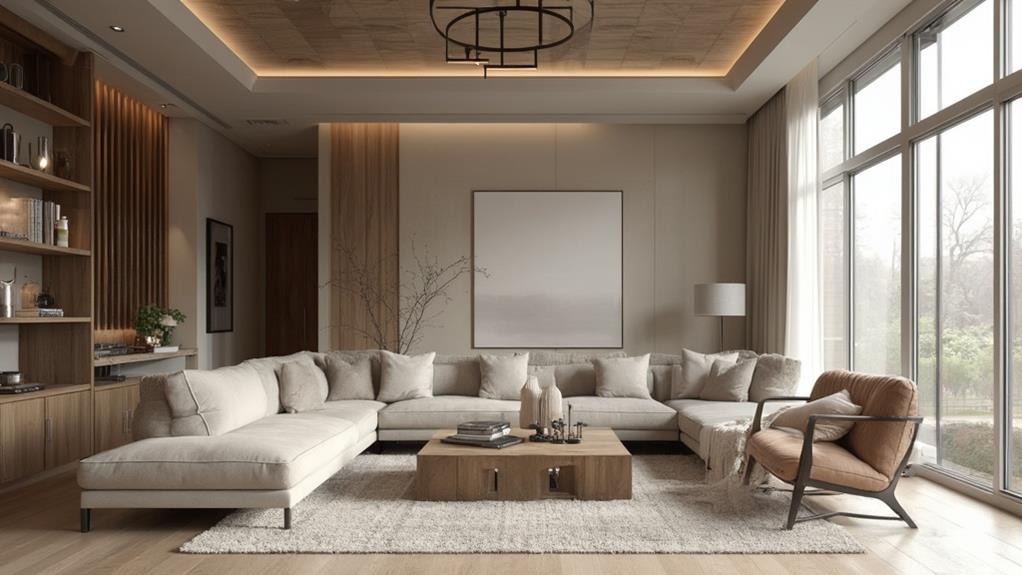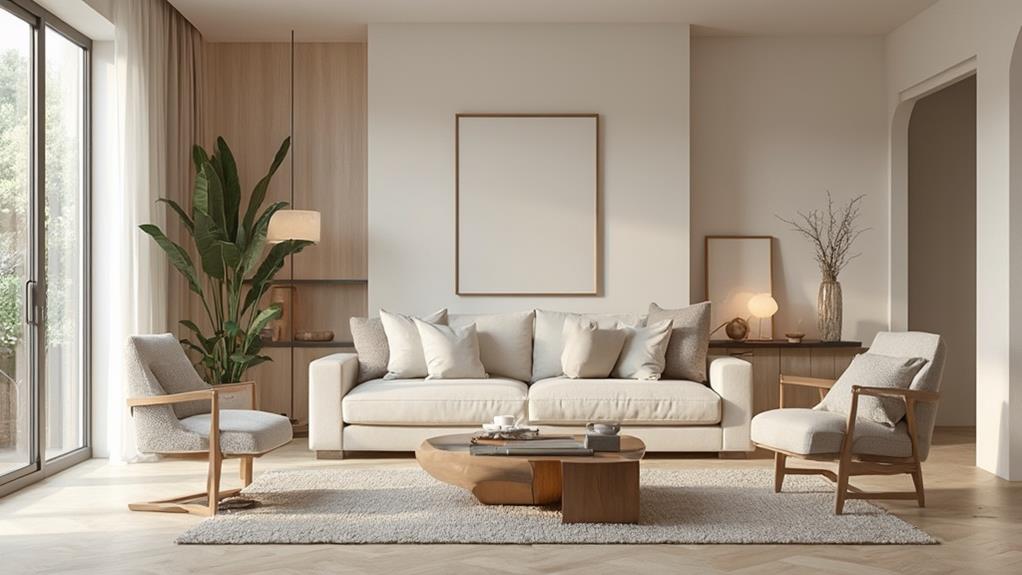Opting for neutral tones like beige, gray, or white can create a stylish and timeless aesthetic in your living room. These tones not only serve as a versatile backdrop, blending seamlessly with various styles, but also make your space feel more airy, calm, and inviting. Remember, it's not just about slapping on a coat of paint. Pay attention to undertones, incorporate neutrals in your furniture and decor, and don't be afraid to experiment. And if you're unsure about the way forward? Don't worry – we've got plenty of case studies and tips that might spark your next big decor idea.
Understanding Neutral Tones

Three key elements form the foundation of any stylish living room: comfort, aesthetics, and balance. Understanding neutral tones is vital to mastering these elements. You might think neutrals are boring, but they're far from it.
Neutral tones, like beige, gray, and white, are the unsung heroes of interior design. They provide a calm, uncluttered backdrop that allows your furniture and accent pieces to truly shine. Neutrals also blend seamlessly with any style, whether you're into mid-century modern, rustic farmhouse, or sleek contemporary.
Adding a statement sofa in a bold color can create a striking focal point against a neutral backdrop.
Imagine your living room as a canvas. Your furniture, artwork, and accessories are the vibrant splashes of color. Without a neutral backdrop, those elements would clash and compete for attention. But with the right neutral tones, everything comes together in harmonious balance.
Don't be afraid to mix and match different neutral shades. You'll add depth and texture to your living room without overwhelming the space.
And remember, your choice of lighting can dramatically affect how these colors appear, so don't overlook its significance. Take the leap into the world of neutrals – you won't regret it.
Exploring Color Psychology

While neutrals can set a harmonious backdrop, the colors you choose for your accents and furniture can greatly impact the mood and atmosphere of your living room.
It's all about color psychology. For instance, reds can evoke passion and energy, blues can inspire calmness and serenity, while yellows may stimulate happiness and creativity.
Delving deeper into color psychology, let's contemplate green. It's often associated with nature, helping to create a calming and restful space.
Want to add a sense of luxury and sophistication? Try incorporating purple accents.
Contrastingly, you could opt for warm oranges and yellows to foster a cozy, inviting atmosphere. These colors are particularly ideal for living rooms where you entertain guests or spend quality family time.
However, it's not just about choosing a color you like. You've got to reflect on the size and lighting of your room as well.
Darker hues can make a large room feel more intimate, while lighter colors can open up a smaller space.
Benefits of Neutral Color Schemes

Even though bold colors may stand out, don't underestimate the power of neutrals. Neutrals bring a host of benefits to your living room, creating a stylish, relaxing space that's easy to decorate.
Neutral tones provide a timeless aesthetic. You're not tied to trends that might quickly go out of style. Instead, neutrals give you a versatile backdrop that pairs well with any design style, whether it's minimalist, traditional, or eclectic. Your living room will always look current and fresh.
Neutrals also offer unmatched flexibility. Want to change your decor seasonally or showcase a rotating art collection? With neutral walls, you can. They form a quiet canvas, letting your furniture, art, and accessories take center stage.
Last, neutrals create a calming, serene atmosphere. They're peaceful and easy on the eyes, inviting relaxation. After a long day, you'll appreciate the tranquil haven your neutral living room provides.
Choosing the Right Neutral Tones

Having understood the advantages of neutral color schemes, your next step is selecting the right neutral tones for your living room.
Don't be fooled into thinking all neutrals are the same. From cool greys to warm beiges, the spectrum of neutrals is vast and offers a plethora of choices.
Start by considering the size and lighting of your room. If your living room is small or doesn't get a lot of natural light, lean towards lighter shades. They'll make the room feel larger and brighter.
For larger rooms with plenty of natural light, you've more freedom to experiment with deeper neutral shades.
Don't forget about undertones. Every neutral color has an undertone, whether cool (blue or green) or warm (red, yellow, or orange).
Identify the undertones in your existing furniture and decor to choose a neutral tone that complements them.
Incorporating Neutral Tones in Living Rooms

You've chosen your perfect neutral tones, so now let's put them to work in your living room. Start by thinking about the larger items in your space. Your furniture pieces can serve as the ideal canvas for these tones. From beige sofas to creamy white rugs, there's no shortage of ways to incorporate neutral tones in your furnishings.
Next, consider your accessories. Items like lamps, throw pillows, and even coffee table books can all be selected in tones that complement your chosen palette. These smaller elements are an easy way to add subtle hints of your chosen neutral colors throughout the room.
Don't forget about textiles. Curtains, throws, and rugs are all excellent places to introduce more of your chosen neutral tones. These can provide not only color, but texture and interest as well.
Lastly, consider your walls. While we aren't delving into paint just yet, think about how art, mirrors, or wall hangings can introduce your neutral tones. These can act as focal points that tie the room together, creating a cohesive and stylish space that truly feels like home.
Paint Makeover With Neutral Tones

Often, a fresh coat of paint is all it takes to completely transform a room. When you're after a calming and sophisticated vibe, neutral tones are your best bet. They're versatile, timeless, and have a way of making your living room appear more spacious.
Starting your paint makeover, you'd want to contemplate the size of your room first. Light neutrals like beige, cream, and off-white can make smaller rooms appear more spacious. For larger living rooms, you can opt for darker neutrals like charcoal or taupe to create a cozy feel.
Don't be afraid to play with different neutral shades. A two-tone wall, for instance, can add depth to your living room. Painting the ceiling a lighter shade can also give the illusion of height.
Role of Color Psychology in Home Makeover

Color psychology plays a pivotal role in home makeovers. It's not just about picking a color you love; it's about choosing hues that evoke the right emotions and responses. Your living room, after all, is where you'll likely spend a lot of time, so why not make it a space that truly feels like you?
Neutral colors, in particular, are masters of subtlety. They can create a calm, serene environment, perfect for relaxation. For instance, beige, a popular neutral tone, is known to promote feelings of warmth and comfort. It's no wonder it's a go-to choice for many living rooms.
If you're seeking a more sophisticated vibe, consider gray. It's a versatile color that can easily adapt to the mood you're aiming for. Darker shades can add depth and drama, while lighter tones can make the room feel airy and spacious.
But remember, it's not just about the color itself, it's also about how you use it. Balance is key. Too much of a single color can feel overwhelming, while the right mix can create harmony.
Styling Tips for Neutral Living Rooms

Let's plunge into the world of neutral living rooms. It's an area where elegance meets simplicity, and where tranquility reigns supreme.
The first tip to styling your neutral living room is to balance your tones. Don't just stick with white or beige, experiment with different shades of grey, cream, and brown to add depth.
Next, textures are your secret weapon in a neutral palette. Soft rugs, plush cushions, and knitted throws can bring a comforting warmth to your space.
Combine this with sleek, glossy surfaces or rustic wooden elements for an interesting contrast.
Don't forget about lighting. It can make or break your neutral room. Opt for layers of light to create different moods at different times. Natural sunlight during the day, accent lights to highlight art pieces, and ambient lighting for evenings will do the trick.
Lastly, add life with indoor plants. Greens are a natural complement to neutral tones and they'll breathe life into your space.
Now, you're all set to create a stylish, warm, and inviting neutral living room. Just remember, the key is in the details.
Case Studies: Home Makeover Success Stories

Three striking home makeover triumphs come to mind when talking about style and functionality. You'd be astonished at how these transformations turned out.
In the first case, a cluttered, chaotic living room was remodeled into a calming oasis, using neutral tones and minimalistic designs. The homeowner ditched the flashy decor and opted for a beige and cream color scheme that exudes tranquility.
You should have seen the before and after pictures, they were night and day.
The second case is of a small, cramped space that was brilliantly transformed into a stylish, functional room. The designer utilized light, neutral hues to give an illusion of space and incorporated sleek, multi-functional furniture.
The result? A room that's not just chic, but also practical.
The final case features a dull, outdated room that was given a modern makeover using a cool-toned, neutral palette. The owner, opting for greys and whites, achieved a fresh, contemporary look without compromising on comfort.

